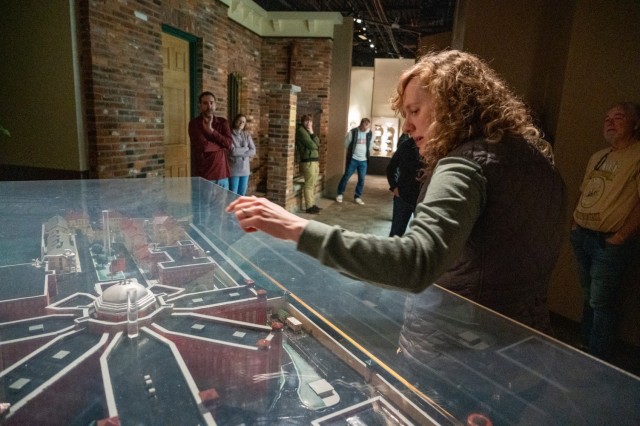FORT LEONARD WOOD, Mo. — Missouri educators got the opportunity to tour all three Army regimental museums housed in Fort Leonard Wood’s John B. Mahaffey Museum Complex Jan. 24, as part of the Museums of Missouri Initiative.
The program brings social studies teachers to workshops at historical sites throughout Missouri to interact with the curators of those places and learn how the resources can be applied in their classrooms.
Rhett Oldham, Social Studies Curriculum director for the Missouri Department of Elementary and Secondary Education, said he is excited to be able to connect teachers with Missouri’s museums.
“I feel like social studies is the most important of all disciplines. People have to know their history to be better United States citizens,” Oldham said. “This program is designed to support passionate teachers who want to get their students engaged in history, government and civics.”
The seven Missouri teachers came from as far away as St. Louis for the guided tour through artifacts from the U.S. Army Military Police, U.S. Army Engineer and U.S. Army Chemical, Biological, Radiological and Nuclear regiments.
Eric Timmerman, John B. Mahaffey Museum Complex director, said opening the doors to the public is vital for the Army as it fosters a deeper understanding of military history and its significance within the broader context of American society.
“This collaboration can inspire future generations, encouraging students to appreciate the complexities of military service and its impact on their lives and communities. Ultimately, engaging educators helps to promote informed dialogue and a shared sense of national identity,” Timmerman said.
Rhonda Koppelmann, a Rolla Junior High School history teacher, said she felt fortunate to be invited to the museum because many of her students “don’t have the opportunity to travel and visit places like Fort Leonard Wood, despite being 30 miles away.”
She said she learned about several artifacts that she was looking forward to sharing with her students.
“If you are excited about it, your students are going to be excited to learn about it. I might be their only opportunity to experience this and bring these lessons back to them,” Koppelmann added.
According to Oldham, teachers have visited several other Missouri museums through this initiative, such as the Battle of Athens State Historic Site, Southeast Missouri State Kent Library and Arabia Steamboat Museum — but Fort Leonard Wood’s museum is the only one on a military installation.
“When I was growing up, I knew several veterans from World War II, the Korean and Vietnam wars, but because less than 1% of the population joins the military now, I think it is more important than ever for children to hear these stories. It is not immediate anymore, most children don’t know anybody that has served in the military,” Oldham said. “Fort Leonard Wood does a great job of telling Soldiers’ stories. Our students need to learn about the smart, innovative and creative people serving in the military.”
Oldham assigned teacher’s the homework of creating a mini lesson based on one of the artifacts they learned about during the tour.
“For instance, the Humvee door with the shrapnel lodged in it. That is a powerful story about how the ingenuity of Americans saved lives with those reinforced doors. That is a story that I would definitely tell in my classroom,” Oldham explained.
Oldham said history teachers are “story tellers” and giving them access to the stories in Fort Leonard Wood’s museum complex allows them to share those stories with hundreds of students.
“It is fun getting tours from the museums’ curators because they are just a wealth of information,” he said. “They are the ultimate story tellers, they are very passionate about this museum, what it offers and the Army’s story.”
According to Timmerman, the curators did an “excellent job” of presenting topics in an accessible way.
“Their enthusiasm and knowledge created a dynamic atmosphere that encouraged great discussions. I look forward to another Museums of Missouri Initiative visit,” Timmerman said.
More information about the regimental museums within the John B. Mahaffey Museum Complex can be found on the Army Museum Enterprise website.




Social Sharing